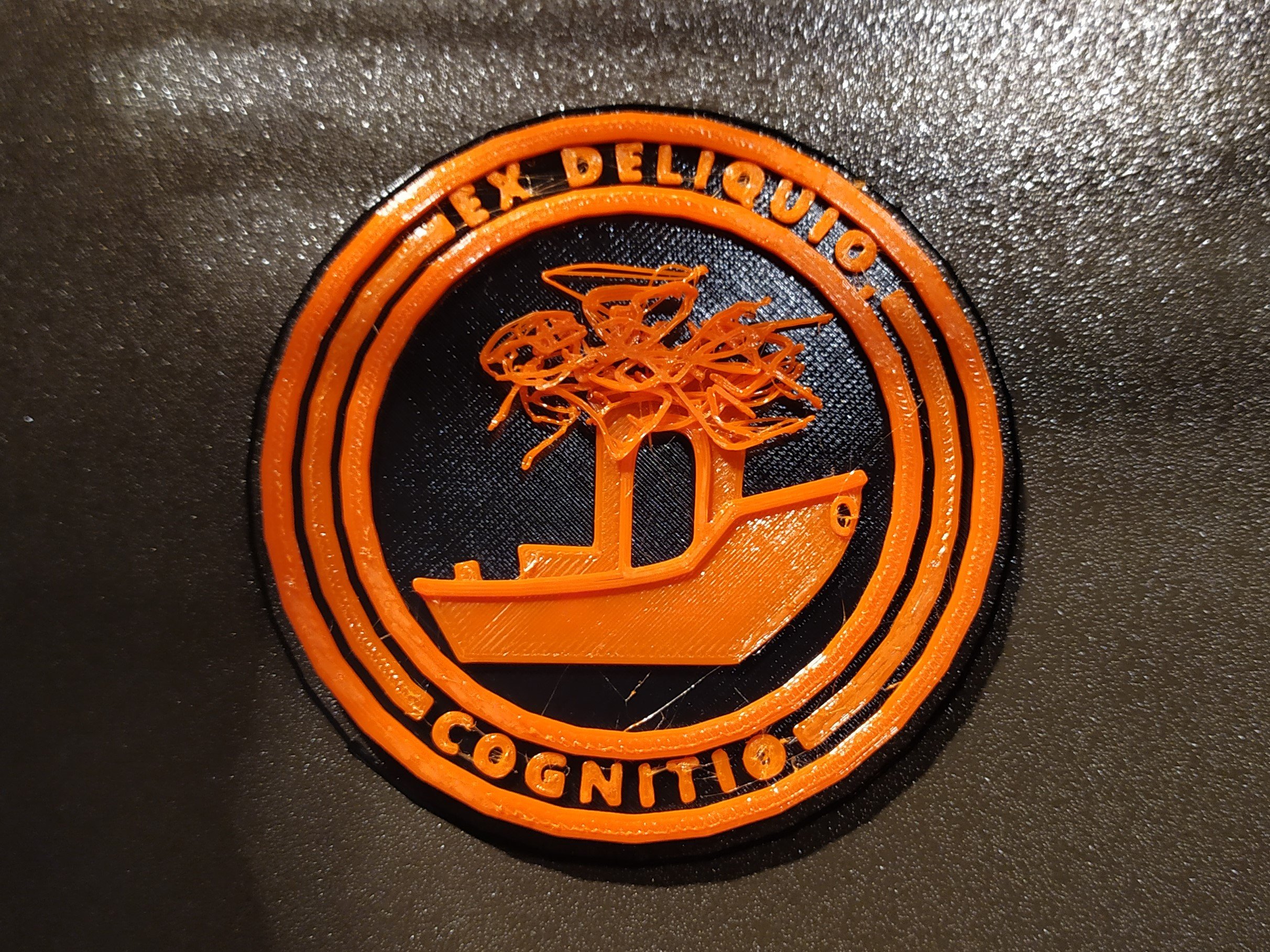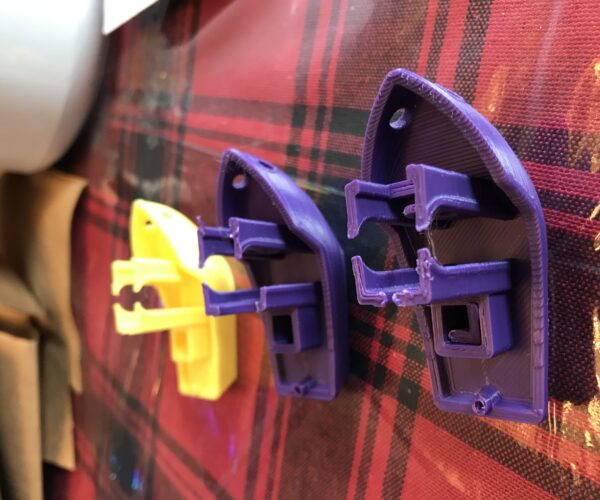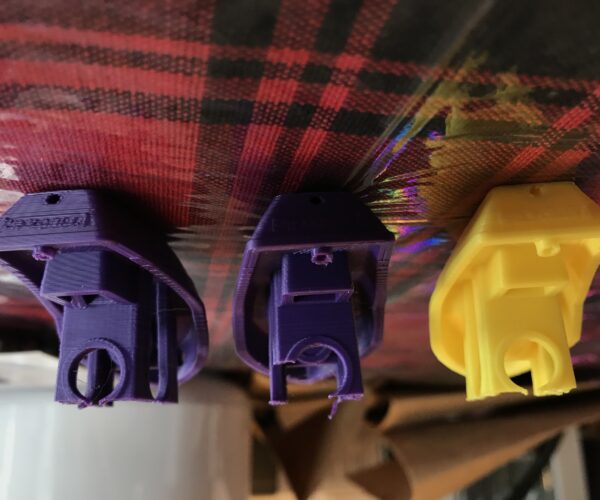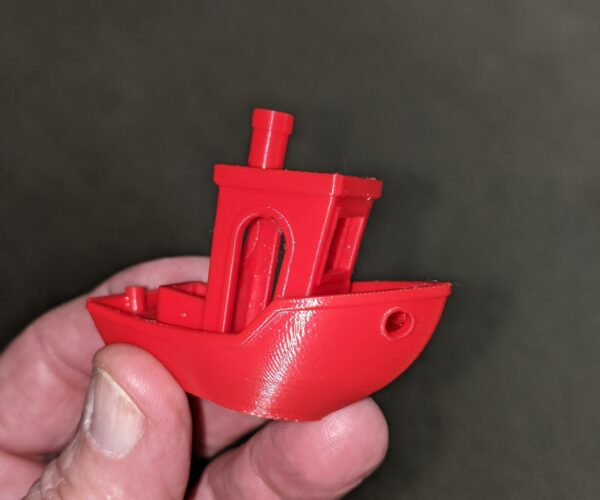RE: Problem printing Benchy - raised section hits nozzle
@trimetric
Do you get much condensation there?
Cheerio,
RE: Problem printing Benchy - raised section hits nozzle
@diem
Not really. The humidity was about 37% at the time. I’m going to move it back down there soon in a lack enclosure so I’ll see if that still has any issues.
RE: Problem printing Benchy - raised section hits nozzle
@trimetric
Does sound like warping due to the cold or maybe damp air in the basement.
Have had many issues in that respect with colder air overnight warping prints off the bed when the temp drops in the room I was printing in.
Are there any draughts in the basement?
Maybe a small heater would help, set to low to just keep the temperature from dropping too far, or a dehumidifier, there are also some options that do both.
Tank you very much!
RE: Problem printing Benchy - raised section hits nozzle
I just ordered a smooth sheet and a couple spare nozzles to have on hand, so I'll next try the Benchy using the smooth sheet and see if that is the answer. Should adhere better to that one than the textured one. Figured it would be good to have one anyway.
Ted
RE: Problem printing Benchy - raised section hits nozzle
@technical-ted
Yeah, I use the smooth sheet for all PLA and no issues with adhesion (even in the cold basement). But for PETG, the textured sheet is awesome. The prints literally just pop off once it cools down and have that sweet surface texture. You won't regret having both.
RE: Problem printing Benchy - raised section hits nozzle
@technical-ted
Ted, I found your thread here by a Google search because I am having the exact same issue at the exact (I think) same point when printing my benchys! However, I'm a Creality printer user (Ender 3 Pro and CR-10 V2) using Cura 4.8.0 to slice the benchy stl file. I've attached a couple pictures here and what's interesting is that the yellow benchy is from my Ender 3 Pro w/4.2.7 32 bit silent board upgrade and the purple ones are from my CR-10 V2 with the stock 8-bit (I believe) silent board and they fail at the same point. My printers both use the Creality coated glass beds (Ultrabase?) and I too have heard the "POP!" of the print coming off the bed.
I have done a couple things like re-sliced the model and slowed the print speed for the walls down to 35 mm/s. My ambient temp is around 64*F so similar to yours but with both printers at temp the room has heated up to ~70*F with no change.
On my CR-10 V2 there are dual Z axis screws and it seems stupidly easy for the two steppers to get out of sync (unlevel) any time the steppers are disabled so that could be a factor though if I level the bed I usually catch that I don't know much about the construction of the printer you are using so no idea if that could be a factor. The other thing is that since the edges of the arches that are being printed are curling up I was thinking maybe we're just printing too hot for the ambient temp and those very thin layers that are trying to bridge the arches are cooling too quickly and curling upwards (since the filament below is warmer) and that's hitting the nozzle.
I'm not an expert but I don't think we are experiencing adhesion problems...I also have very little experience looking at gcode but thought I might try as the failure seems to be somewhere between layers 156 and 159 (the first layer where the back window is completely bridged). Or maybe I'll try going back to an earlier Cura and see if that could be an issue. In any case, just wanted to let you know I'm having this same, strange and repeatable failure on this model as well. If I find a solution, I'll let you know!
Regards,
Frank (93fd3s)
RE: Problem printing Benchy - raised section hits nozzle
I'm actually kind of surprised that no one has chimed in on this thread yet with the actual answer. What you all are seeing in your print is warping due to the overhang perimeters shrinking drastically and pulling the filament upward into the visible curl. The filament selection can play a role (Overture PLA Pro in light blue is my nemesis for this issue) so trying other PLA filaments can reduce/eliminate this problem. Other things to try are printing in a warmer environment (enclosure if you have one but probably not necessary), reducing the cooling fan speed, slowing the print speed, reducing the nozzle temperature, etc. The objective is to reduce the rapid cooling to allow the filament to "harden" before it warps. If you are slicing your own Benchy with PrusaSlicer then turning on "Detect Bridging Perimeters" in the "Print Settings" tab (you need to be in at least "Advanced" mode to see the option) can help as it adjusts flow and speed for detected "unsupported" perimeters such as these.
Hope this helps,
Steve
RE: Problem printing Benchy - raised section hits nozzle
I'm actually kind of surprised that no one has chimed in on this thread yet with the actual answer. What you all are seeing in your print is warping due to the overhang perimeters shrinking drastically and pulling the filament upward into the visible curl. The filament selection can play a role (Overture PLA Pro in light blue is my nemesis for this issue) so trying other PLA filaments can reduce/eliminate this problem. Other things to try are printing in a warmer environment (enclosure if you have one but probably not necessary), reducing the cooling fan speed, slowing the print speed, reducing the nozzle temperature, etc. The objective is to reduce the rapid cooling to allow the filament to "harden" before it warps. If you are slicing your own Benchy with PrusaSlicer then turning on "Detect Bridging Perimeters" in the "Print Settings" tab (you need to be in at least "Advanced" mode to see the option) can help as it adjusts flow and speed for detected "unsupported" perimeters such as these.
Hope this helps,
Steve
I said it on page one. Go back and take a look.
RE: Problem printing Benchy - raised section hits nozzle
@steve-5
I'm using the sample G code that came on the SD card with my new machine so I assumed that it was tweaked for using their Prusa filament that also came with the machine... You've given me some setting suggestions to play around with and I'll find a file that I can slice myself and play with the settings. You and others seem to agree with me (although some of you don't) that is it not an adhesion problem, but something else.
Thanks for the help everyone,
Ted
RE: Problem printing Benchy - raised section hits nozzle
Ted,
I understand, the Pre-sliced g-code that comes with the printer is indeed optimized pretty well for the PLA material that is provided. Unfortunately they cannot predict all environmental factors involved and so even with proper files there are some variables that can create issues. I personally don't see any evidence that you have 1st layer or bed adhesion problems and the model is too small for localized adhesion problems to manifest.
One other thing that I didn't mention in my previous post is that if you watch closely while the print is happening you can see the "curl" happen and perhaps even push it down with a popsicle stick or similar implement to get it straightened before the PLA "sets". This could allow you to at least complete the Benchy to see if you have any other issues.
Good luck and happy printing 🙂
Steve
RE: Problem printing Benchy - raised section hits nozzle
If you want to see what settings pre-generated gcode was sliced with, import the gcode file into PrusaSlicer as a config. Any settings that were changed from the presets will be highlighted. There's nothing particularly interesting about the benchy gcode sample, other than that they did increase z-lift from 0.4 to 0.6mm and they slowed down some speeds. It is using the old LA1.0 values in the filament start gcode.
As far as the arch warping upwards before bridging, that is certainly nothing new. Thousands have printed 3Dbenchy using the Prusa sample gcode out of the box with the "Made for Prusa" Filament-PM silver filament without it popping off. If it's popping off, you've got something else going on. It should be a relatively easy print using the unmodified gcode with the sample filament if you've got everything set up right.
I would try it on a smooth PEI sheet if you've got one available.
and miscellaneous other tech projects
He is intelligent, but not experienced. His pattern indicates two dimensional thinking. -- Spock in Star Trek: The Wrath of Khan
RE: Problem printing Benchy - raised section hits nozzle
@bobstro
Ordered one and it's on its' way to me now. Should have it in hand next week. I'll try that and see how it turns out.
Ted
RE: Problem printing Benchy - raised section hits nozzle
My textured sheet was a notorious turd with any filament, from PETG to PLA. Other folks have great success with them, but I notice Prusa's description of the textured sheet turned from it being the ideal surface for any print, so best suited for larger PLA prints or PETG. I ditched my Prusa textured sheet out of frustration and replaced it with one that works well.
and miscellaneous other tech projects
He is intelligent, but not experienced. His pattern indicates two dimensional thinking. -- Spock in Star Trek: The Wrath of Khan
RE: Problem printing Benchy - raised section hits nozzle
Lots of things this could be:
1. I find the textured sheet to be unforgiving with PLA - this *might* be the problem alright - its very difficult to get clean enough for PLA
2. Look underneath your nozzle and check that the wiring isn't bulging at any point (make sure its more or less flat and snugly tucked under clips).
3. I suspect however that cooling might be the issue - verify that the insert for the cooling fan is straight (the newest MK3S+) has a more exact screw thread than previous versions, but make sure the fan is snugly clipped in and not slightly angled. If you go to settings on the printer it lets you set the fan at values up to 255. With the nozzle at room temp, set this to 255 and put your finger under to make sure there is an airflow.
The smooth sheet might sort you out though - good luck with the new sheet when it arrives.
RE: Problem printing Benchy - raised section hits nozzle
My textured sheet was a notorious turd with any filament, from PETG to PLA. Other folks have great success with them, but I notice Prusa's description of the textured sheet turned from it being the ideal surface for any print, so best suited for larger PLA prints or PETG. I ditched my Prusa textured sheet out of frustration and replaced it with one that works well.
I’ve never really used it for PLA other than a few samples and a failed benchy similar to the OP.
However, for PETG I can’t imagine how anything could pop loose from it. I wipe it down with 91% IPA before each print and I can’t even budge the parts until it either cools down a little or I remove and flex the sheet a few times.
RE: Problem printing Benchy - raised section hits nozzle
So far, I've found that other PLA pieces have seem to stick quite well to the textured sheet, but I have no point of reference for comparing to the smooth sheet, as I have not received it yet. But, I have found that these Impossible Dovetail parts which are 1.312" square stuck so well I had to wait until the sheet cooled before I could easily pull them off. They stuck on there tight enough where I could pull quite hard and they didn't come off, easily being able to hold the weight of the textured sheet in the air (after I removed off the heat plate).
RE: Problem printing Benchy - raised section hits nozzle
Update: I did get a successful benchy and it turned out very well. I used my new smooth sheet. I watched and listened carefully in the trouble areas over the doors and I could hear a "thump" every time the nozzle hit the warped spots! I was expecting it to break free, but the additional adhesion of the smooth sheet made it impossible for the nozzle to break it free. So, although the warping was the root cause, the additional adhesion allowed the benchy to withstand the pounding of the nozzle.
Now it seems I have to deal with removing the PLA prints when finished from the smooth sheet! After allowing a complete cooldown and flexing the sheet several times I got the benchy off, but I had a very difficult time removing the skirt. Now I understand the difference in adhesion with PLA between the two sheet types. I'll stick with the textured unless I have trouble with adhesion on a print and then switch over to the smooth. I'll do some research now on removing prints when stuck.
Thanks all to the help!
Ted
RE: Problem printing Benchy - raised section hits nozzle
Update: I did get a successful benchy and it turned out very well. I used my new smooth sheet. I watched and listened carefully in the trouble areas over the doors and I could hear a "thump" every time the nozzle hit the warped spots!
Keep in mind, that spot of Benchy is specifically meant to be a challenge to print. There's a reason this is a meme in the 3D printing community.

I was expecting it to break free, but the additional adhesion of the smooth sheet made it impossible for the nozzle to break it free. So, although the warping was the root cause, the additional adhesion allowed the benchy to withstand the pounding of the nozzle.
All severe overhangs are going to warp or flex without support. You'll also notice those parts being depressed as additional layers are applied on top. You can reduce that somewhat with cooling and temperatures, but ultimately, your adhesion has to be strong enough to allow some bumping into imperfections in the underlying layer. So yes, those areas warp -- by design -- but that is part of the Benchy challenge.
Now it seems I have to deal with removing the PLA prints when finished from the smooth sheet! After allowing a complete cooldown and flexing the sheet several times I got the benchy off, but I had a very difficult time removing the skirt.
Make sure your Live-Z isn't too low. You might back it up (make it less negative) by 0.02-0.04mm to see if that still gives a good 1st layer without adhering too much. The PEI sheets do seem to "season" with use, so you'll find a good balance. The main thing is to let it cool -- like completely cool -- if you're getting too much adhesion. Don't go banging on it prematurely.
A plastic razor helps with removing prime lines and skirts. I avoid using anything metal.
Now I understand the difference in adhesion with PLA between the two sheet types. I'll stick with the textured unless I have trouble with adhesion on a print and then switch over to the smooth. I'll do some research now on removing prints when stuck.
There is a lot of variation in the Prusa textured sheets. Some people can only get good adhesion with PETG. Others get amazing adhesion with PLA and PETG. Mine wouldn't stick to anything. I replaced it with a TheKKIINNGG clone and that works exactly as expected with no change in my routing. Smooth PEI is probably the best option for all-around use for new users, although it does take a few prints to master. You definitely shouldn't need to resort to a brim to get a good Benchy print on a Prusa printer.
Benchy looks good. Congratulations!
and miscellaneous other tech projects
He is intelligent, but not experienced. His pattern indicates two dimensional thinking. -- Spock in Star Trek: The Wrath of Khan
RE: Problem printing Benchy - raised section hits nozzle
@bobstro
That is very helpful and useful information. Thank you very much!
Question: When changing the values using Live-Z, is the display in mm? So raising the nozzle a value of .020 on the display (say from -1.220 to -1.200) would equal raising the nozzle 0.020mm?
Thanks,
Ted
RE: Problem printing Benchy - raised section hits nozzle
Question: When changing the values using Live-Z, is the display in mm? So raising the nozzle a value of .020 on the display (say from -1.220 to -1.200) would equal raising the nozzle 0.020mm?
Yes. Live-Z is essentially a correction for the 0 (zero) position. Negative adjustment lowers the nozzle closer to the bed, positive raises it. (Interesting note: It was reversed on the Mk2 printer, which sometimes causes confusion here.) I find 0.02mm about the smallest adjustment that makes a difference in my Live-Z settings. With just a bit of practice, I've gotten to the point that I can make a call on adjusting Live-Z based on a quick visual inspection. A bit of gap between extrusions means I need to lower it 0.04-0.06mm. A bit of a rough surface means I need to raise it a similar amount. Then adjust with +/- 0.02mm bumps. I'm finding the same values work equally well on my Sidewinder printer.
I found it helpful not to worry too much about the "true zero" position. I wasted a lot of time following online discussions about carefully adjusting the nozzle so it touches the bed in that position, then adjusting up from there. I finally realized the Mk3 won't let you go below 0.15mm anyhow. When my 0.2mm 1st layer prints evenly, it is "correct". If I ever need very accurate 1st layer heights (I usually don't), I can make minor adjustments to Live-Z, but otherwise, I only care if the 1st layer adheres and provides a good foundation for the higher layers.
Glad to hear the info is useful. Let me know if you spot any errors or improvements!
and miscellaneous other tech projects
He is intelligent, but not experienced. His pattern indicates two dimensional thinking. -- Spock in Star Trek: The Wrath of Khan




